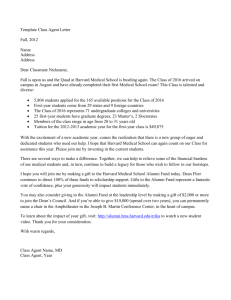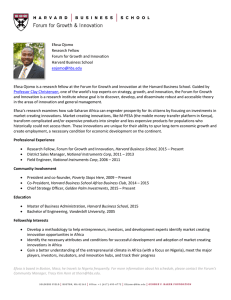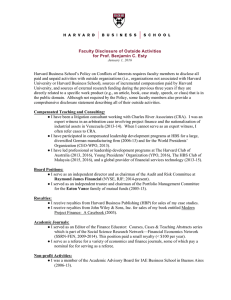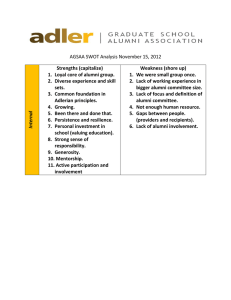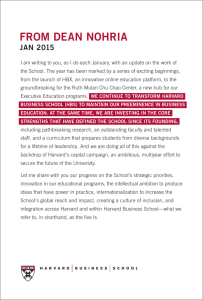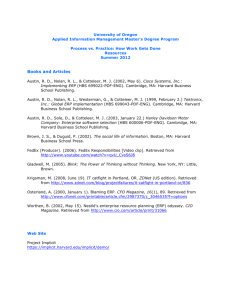FROM DEAN NOHRIA JAN 2016
advertisement
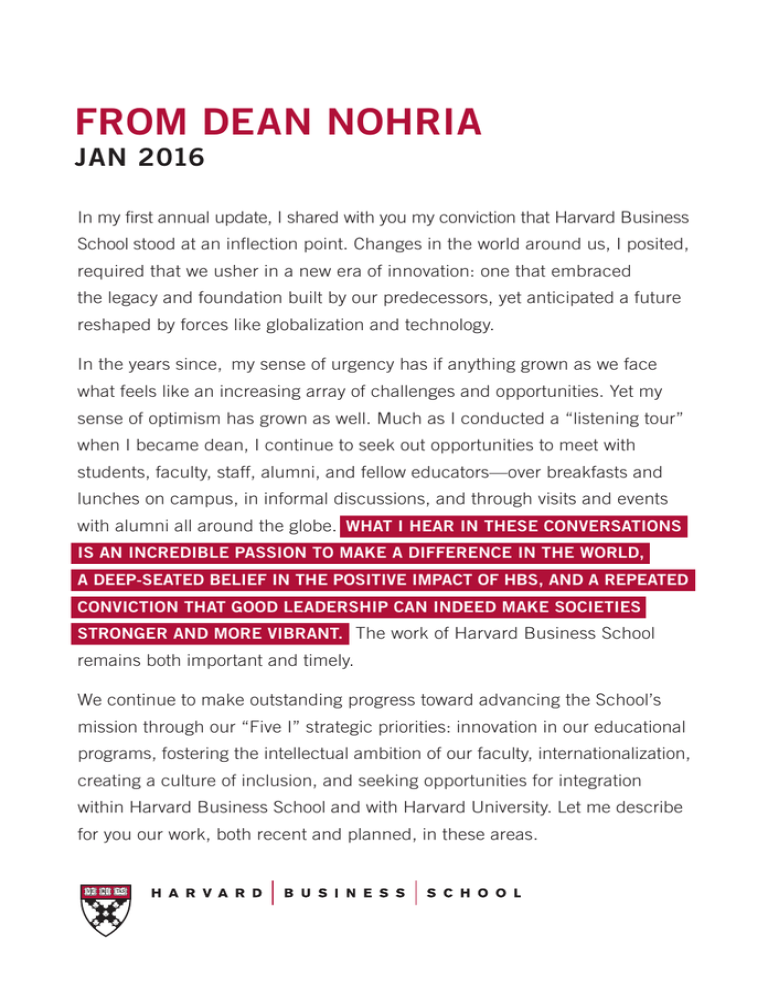
FROM DEAN NOHRIA JAN 2016 In my first annual update, I shared with you my conviction that Harvard Business School stood at an inflection point. Changes in the world around us, I posited, required that we usher in a new era of innovation: one that embraced the legacy and foundation built by our predecessors, yet anticipated a future reshaped by forces like globalization and technology. In the years since, my sense of urgency has if anything grown as we face what feels like an increasing array of challenges and opportunities. Yet my sense of optimism has grown as well. Much as I conducted a “listening tour” when I became dean, I continue to seek out opportunities to meet with students, faculty, staff, alumni, and fellow educators—over breakfasts and lunches on campus, in informal discussions, and through visits and events with alumni all around the globe. WHAT I HEAR IN THESE CONVERSATIONS IS AN INCREDIBLE PASSION TO MAKE A DIFFERENCE IN THE WORLD, A DEEP-SEATED BELIEF IN THE POSITIVE IMPACT OF HBS, AND A REPEATED CONVICTION THAT GOOD LEADERSHIP CAN INDEED MAKE SOCIETIES STRONGER AND MORE VIBRANT. The work of Harvard Business School remains both important and timely. We continue to make outstanding progress toward advancing the School’s mission through our “Five I” strategic priorities: innovation in our educational programs, fostering the intellectual ambition of our faculty, internationalization, creating a culture of inclusion, and seeking opportunities for integration within Harvard Business School and with Harvard University. Let me describe for you our work, both recent and planned, in these areas. INNOVATION IN OUR EDUCATIONAL PROGRAMS The case method has been the hallmark of the HBS learning experience for nearly a century. In 2010, we added the field method to our lexicon: immersive, experiential learning opportunities that advance the knowing, doing, and being of leadership by putting students in real-world settings and requiring them to implement (and integrate) their ideas. Field Immersion Experiences for Leadership Development (FIELD), a yearlong required course in the first year of the MBA Program, was launched We have been working to incorpo- in fall 2011. Building on our experience with rate field method courses in the FIELD, we have been working to incorporate second-year Elective Curriculum field method courses in the second-year Elective Curriculum (EC) as well, and now have offerings (EC) as well, and now have that engage more than a third of our MBA stu- offerings that engage more than a dents. Immersive Field Courses take place in third of our MBA students. January and allow students to go deep in a geography or sector—from real estate in New York City to social enterprise in India. Extended Field Courses unfold over a semester with hands-on Five years into FIELD, we have undertaken a practical exposure on topics ranging from de- full review to assess how we might continue to sign thinking to project management. Whatever refine and enhance it. Is January the best time the format, students engage in project work for the FIELD 2 global immersion, for example, with partner organizations under the supervision or might it be better situated later in the se- of a faculty member. Many students report that mester when students are able to draw on ad- the experience changes how they think about ditional insights from courses such as Strategy the careers they will pursue. Based on their and Business, Government, and the Interna- field experiences in an EC course on the finan- tional Economy? FIELD 3, where small teams cial management of smaller firms, for example, design and launch a new venture, has had a a number of students from the Class of 2015 bimodal student response: Some find it trans- decided to launch a search fund that would en- formative, while others tune out and invest lim- able them to acquire and run a small business. ited effort. Should it continue to be required 2 or should it become an elective? Are there other required FIELD experiences we might introduce? These are the types of questions we are exploring. Beyond FIELD, the MBA curriculum remains We saw robust growth in all our HBX online offerings—about 3,500 participants in CORe, 500 dynamic: faculty members work constantly to in Disruptive Strategy, and 2,000 update cases, introduce new courses, and across 50 sessions of HBX Live. evaluate and enhance existing courses to ensure that the whole is greater than the sum of the parts. Last spring, we introduced a capstone program for graduating students called I’ve highlighted the case method and the field Bridges. Over three days, students reflected method. The third pedagogical approach we on their two years, synthesized what they have developed is HBX, our online platform learned, planned for reentering the workforce, that encompasses programmatic courses like and brought closure to their HBS experience. CORe (a primer on the fundamentals of busi- One measure of the program’s success was ness) and specialized courses like Disruptive the near-universal belief that it had always ex- Strategy (which build on the ideas of individual isted. Students simply couldn’t believe that faculty members, in this case Clayton Chris- their predecessors had graduated without it. tensen), as well as the HBX Live studio (a virtual manifestation of the physical HBS classroom experience). We saw robust growth in all of these online offerings—about 3,500 par- One measure of Bridges’ success ticipants in CORe, 500 in Disruptive Strategy, was the near-universal belief that and 2,000 across 50 sessions of HBX Live. it had always existed. Students simply couldn’t believe that their predecessors had graduated without it. While we will continue to build out courses that reach new audiences and engage our alumni, increasingly we are interested in ways that HBX might be incorporated in our existing educational programs. Over 300 of our MBA students who began the program in September innovation continues → 3 took HBX CORe before matriculating, and faculty members and students alike report they are better prepared to succeed in the first year Over 300 of our MBA students curriculum. In the General Manager Program who began the program in in Executive Education, we used HBX Live to September took HBX CORe before engage participants between modules. Taken together, we now have three unique and distinctive ways to deliver a transformative matriculating, and faculty members and students alike educational experience. How do we help faculty report they are better prepared leverage these approaches in designing courses to succeed in the first year that engage students and participants and, curriculum. eventually, alumni and others as well? The possibilities here are truly exciting. The full platform of educational opportunities we provide positions us uniquely to serve anyone considering a business education at any stage in their life. However, we now are thinking hard about the people who are no longer convinced that it is worthwhile to gain a formal business education, and thus are not applying to business school at all. 4 INTELLECTUAL AMBITION While united by a desire to influence management practice and education, faculty members come to Harvard Business School today employing a wide and increasing number of research methodologies: some measure aspects of human physiology to understand responses to various marketing stimuli; others use ethnographic studies to gain insight into individual behavior and motivations; some carry out large-scale interviews and surveys to learn what contributes to company performance; others analyze large data sets to build empirically informed theory; and yet others use lab and field experiments to tease out behavioral and organizational insights. Harvard Business School supports all these research teams? Given the remarkable success types of research. Our goal is to provide mem- of the Harvard Innovation Lab (i-lab) in foster- bers of our faculty with unmatched resources— ing student ideas, should we develop a faculty largely through internal funding, freeing them research i-lab? from the burdens associated with seeking grants and other external funding. This patient capital Beyond individual faculty research, the School allows them to pursue ambitious long-term re- also invests in advancing interdisciplinary ini- search projects and to develop ideas that have tiatives and projects that bring together faculty enduring power in practice. members from across units to address issues of significant relevance to business and society. In recent years, though, we have begun seeing more faculty members whose work requires a budget that is significantly higher than the norm. This has led us to create a handful of working groups to address several questions: Should we be more open to outside funding? Additionally, in what ways might we foster re- The Business and Environment Initiative, for example, has developed numerous cases on how firms can reduce their environmental footprint—cases that serve to educate not just our own students, but also those in most other MBA programs around the world. Building on search collaboration? Are there physical space configurations that would boost the work of intellectual ambition continues → 5 a rich tradition of understanding the rise of capitalism in advanced economies, the Business History Initiative is gathering oral histories Inspired by the reach and impact that will document the rise of business enter- of the U.S. Competitiveness prises in emerging markets. The focus of the Project, we are in the process of Digital Initiative is to study the far-reaching im- launching a new project on pact of the digital revolution on firms, industries, and societies. The Gender Initiative con- Behavioral and Institutional venes the best scholars in the field to promote Finance to study how to build a gender equity in business and society and con- more robust financial system tinues to develop understanding from recent surveys of the School’s alumni. The Health that is less vulnerable to systemic Care Initiative has launched a new project on risks and yet is able to deliver advancing precision medicine, even as it con- innovative financial products and tinues to study how to make the health-care system more efficient and effective. Our Lead- services that benefit the economy. ership Initiative is developing innovative new courses that push the frontiers of leadership development. Finally, the Social Enterprise Initiative is studying different approaches to im- help move our deepening understanding from pact investing to complement ongoing work ideas into action, last June we launched the on how to build and manage enterprises that Young American Leaders Program, bringing address unmet social needs. All of these ini- together small groups of high potential leaders tiatives build and support vibrant communities from different sectors of a city or state (busi- of HBS students and alumni. ness, local government, school districts, and The U.S. Competitiveness Project, now in its social enterprise) to jointly explore how they fifth year, recently completed its fourth alumni can improve their region’s competitiveness. survey. The findings show that while the U.S. Inspired by the reach and impact of the Com- economy has regained some measure of com- petitiveness Project, we are in the process of petitiveness in terms of how firms are faring, it launching a new project on Behavioral and In- is only doing half its job, as the living standard stitutional Finance to study how to build a more of American citizens continues to stagnate. To robust financial system that is less vulnerable 6 to systemic risks and yet is able to deliver innovative financial products and services that benefit the economy. Can we combine our people, our spaces, and our pedagogies and We also are eager to explore how we might truly realize a unique capacity at HBS to con- tools in a way that is distinctive to vene leaders across sectors and industries. the School, and that will help open We will be breaking ground on the Klarman a dialogue around (and lead to Center, a beautiful new facility that will seat more than a thousand people and incorporate action on) the challenges facing technology to engage even more, in April 2016. the world today? Can we combine our people, our spaces, and our pedagogies and tools in a way that is distinctive to the School, and that will help open a dialogue around (and lead to action on) the challenges facing the world today? This is an area that holds tremendous promise, as witnessed by the incredible reactions of our alumni to events and activities like our reunions, the W50 Conference, industry focused symposia such as the asset management, private equity/venture capital, and real estate conferences, and the Rock100 conference for entrepreneurs of pre-IPO companies. 7 INTERNATIONALIZATION Harvard Business School today is inherently international: with more than a third of our MBA students, half of our Doctoral students, and nearly two-thirds of our Executive Education participants coming from countries outside the United States, our classrooms reflect a global perspective. And, relative to when I first joined the faculty, our curriculum now more fully reflects global business practices. Our international strategy has been one of en- Our international centers also support Harvard gagement through regional research centers Business Publishing (HBP), which has a grow- that, first and foremost, foster faculty research ing number of foreign-language editions of and course development. Deepening the fac- Harvard Business Review (with local authors ulty’s understanding of global business and and content) and partnerships with business relationships with global companies is what schools around case and curriculum develop- leads to new cases and courses in all our ed- ment. Our international publishing activities ucational programs that feel timely and rele- have experienced rapid growth, and now ac- vant. During 2015–2016 well more than half of the 250+ new cases written by HBS faculty count for more than a third of HBP’s $200 million annual revenues. were global in location or content. Moreover, our centers facilitate the development of regional Executive Education pro- During 2015–2016 well more than half of the 250+ new cases written by HBS faculty were global in location or content. grams: In locations from China to India to Latin America to Africa, we are offering focused programs that look at local business issues in the context of global business practice. Finally, the centers play an important role in keeping the School connected to alumni, hosting lectures with faculty who are visiting and working with regional advisory boards, for example. This year we expanded our network of centers with a handful of regional offices in Singapore, 8 role in exposing faculty members to interesting This year we expanded our net- and innovative companies. During the coming year faculty will travel to Germany to explore work of centers with a handful innovation, sustainability, and globalization of regional offices in Singapore, through visits to Germany’s famed mittelstand Dubai, and Israel. These lean (midsize) companies, large multinationals, and research institutions. They’ll also participate entities typically comprise just a in a half-day seminar to share their research researcher on-site; we think of with local alumni and business leaders. them as initial forays into a location that will help develop faculty interest and relationships with companies and alumni. Dubai, and Israel. These lean entities typically comprise just a researcher on-site; we think of them as initial forays into a location that will help develop faculty interest and relationships with companies and alumni. We will continue to look at regions of the world where the combination of student activities, alumni engagement, and faculty interest may warrant a future presence. For now, Africa is perhaps the most notable gap in our coverage. We are eager to explore how we might leverage the University’s plans and activities in ways that dovetail with our own. Beyond the research centers, faculty immersions and travel fellowships play an important 9 INCLUSION Harvard Business School is an institution committed to ensuring that every member of the community is able to thrive and do their best work. We realize this first by ensuring that we are able to admit students from a wide range of backgrounds to our programs, regardless of their financial means. All of our Doctoral students receive fellowships dent leaders discovered that although first-year to cover the full cost of tuition and expenses students cherished the camaraderie of their over the duration of their education, as well as sectionmates, many yearned to form closer a modest annual living stipend. In the MBA friendships at HBS. In response they launched Program, nearly 900 students—about half of a program called Evolve, where small groups of the student body—receive financial aid aver- students get together every other week for two aging nearly $33,000 per student in fellowships. hours. Nearly all groups continue to meet for While many people think of the HBS student the full year, and they use the sessions to share body as being elite, the reality is that the MBA deeply personal issues—everything from their Class of 2017 includes 87 students (almost 10 family life to academic challenges to their great- percent of the class) who are the first in their est career fears and aspirations. More than 400 families to attend college. students participated in the pilot and reported feeling a deeper sense of belonging and con- After they enroll, we aspire to create an environment where every student can achieve their full potential. In years past, I have outlined our attempt to close the gender gap with regards to nection at HBS. Similarly, students in two of the residence halls are exploring how they can build more of a community atmosphere in these living spaces. academic honors at the School. We also have been working to close the satisfaction gap—for In October, the Association of American Uni- women, minority, and international students— versities (AAU) released the results of its first and through the combined efforts of faculty, multi-school survey on sexual conduct. At Har- staff, and students, for the first time we are see- vard Business School, 45 percent of our stu- ing no statistical difference across these groups dents completed the survey. There were glim- in their overall experience of the MBA Program. mers of encouraging news: Our students believe Not surprisingly, ensuring that students take that we would take reports of incidents seriously, the lead and working with them to support their for example. But the overall picture was bleak efforts has proven to be key. For instance, stu- and deeply troubling. Roughly 45 women and 10 better understand and address this troubling Making these difficult issues reality. As in so many other things, I am finding that making these difficult issues discussable discussable is a crucial first step— is a crucial first step—whether to raise aware- whether to raise awareness, ness, develop a shared and informed under- develop a shared and informed effecting change. standing of the issues, or begin the process of understanding of the issues, or Finally, given the protests unfolding on college begin the process of effecting campuses across the United States, it is im- change. portant to address issues of racial diversity and inclusion at HBS. In short, despite efforts over many years, we have work to do. A quick analysis of the curriculum reveals too few cases with 10 men from the sample—a full section of students if we extrapolate the results to the full population—reported some form of nonconsensual sexual violence during their time at HBS. Nearly three-quarters of the incidents involved a fellow student. Less than one-third of the students reported the incident or contacted Harvard resources, most often because they did not want to get someone in trouble. Clearly we cannot be an inclusive community if black protagonists. We must strive to develop an even deeper pipeline of minority applicants to our educational programs. And the numbers of our black staff and faculty, while consistent with those at peer business schools, are low. We are just at the beginning stages of conversations about steps we might take, and I look forward to reporting on our ideas and progress in the coming years and as we celebrate the 50th anniversary of the founding of the AfricanAmerican Student Union in 2018. so many of our students experience sexual violence. Here, too, we are partnering with students as they lead efforts to explore how they can better manage their use of alcohol, raise awareness through education, and bolster bystander training. We have held a town hall, and I am discussing the findings in a series of small group meetings with faculty throughout the year. Our aim is to seek out creative approaches to 11 INTEGRATION We launched the Harvard Innovation Lab in 2011 with high hopes and modest expectations. Last month the i-lab celebrated its fourth anniversary, during which time it has hosted 175,000 student visits (many of them repeat visitors, of course), 3,800 events, 500,000 unique website visitors, 575 teams in its venture incubation program, and 950 teams in various President’s and Deans’ Challenges. More than 75 companies have gone on to market, raising more than $250 million in funding. The i-lab engages more than one hundred En- the groundwork, is that with the John A. Paul- trepreneurs-in-Residence, mentors, and alumni son School of Engineering and Applied Sci- advisors. By any measure, it has exceeded our ences (SEAS), which will be moving to Allston aspirations—so much so that, in response to during the 2018–2019 academic year. We see demand from graduating students, last year we tremendous synergy among our faculties in the opened a Launch Lab for alumni ventures. In its short lifespan it has been home to 30 companies with founders from eight different Harvard schools; already, this past summer, we We see tremendous synergy doubled its size to accommodate more teams. among our faculties in the area of We recently received approval for a third com- innovation and entrepreneurship. ponent: A wet lab to support ventures in the life sciences. With this, we hope to foster an ecosystem of innovation inspired by the unparalleled richness of the life sciences community at Harvard and in Boston more broadly. The wet lab will open in Fall 2016, utilizing a modular construction that allows us to realize our vision rapidly. area of innovation and entrepreneurship, and are planning a joint research symposium this coming spring to spur collaboration. We foreshadowed the exciting potential of this collaboration in October when we organized a joint event as part of Boston’s HUBweek on the One key area of integration about which we are technological and commercial challenges of deeply excited, and for which we are now laying unmanned aerial vehicles. From live demon- 12 more ways to reach new audiences, we run Unlike in years past, we have a the risk of developing silos of expertise that are incredibly effective in their work, but that steady stream of undergraduate fail to consider challenges (or customers or students crossing the river for clients) from a holistic point of view. Looking classes in Aldrich, and a handful internally for ways to collaborate and leverage the School’s resources is a conversation I’ve of faculty members making the begun on campus through town halls, faculty reverse trek. meetings, and other forums. strations of drones flying in Harvard Stadium to case discussions that brought together scientists, entrepreneurs, and regulators, the event showcased the possibilities that exist at the intersection of HBS and SEAS. Members of our faculty continue to engage in University leadership and teaching. This year, HBS faculty members are heading or coheading the Advanced Leadership Initiative, the Center for Public Leadership, the Davis Center for Russian and Eurasian Studies, Harvard College, the Harvard i-lab, and the South Asia Institute. Unlike in years past, we have a steady stream of undergraduate students crossing the river for classes in Aldrich, and a handful of faculty members making the reverse trek. We view all of these activities as crucial to supporting President Drew Faust’s vision of “One Harvard.” We also are looking at how to foster integration within Harvard Business School. As we find 13 THE HARVARD BUSINESS SCHOOL CAMPAIGN Now, as in generations past, Harvard Business School has been able to innovate and remain a leader in business education because of generous benefactors. We have received tremendous support from We have begun to recruit a handful of alumni the School’s alumni and friends during our who will serve as cochairs and help drive this Campaign, which began its quiet phase in 2012, next phase of our Campaign in partnership with launched publicly in April 2014, and will end John Hess, who has so admirably served as in summer 2018. To date, we have raised nearly our overall Campaign chair. We are equally fo- $900 million toward our $1 billion goal. This is cused on encouraging each and every alumnus a remarkable testament, by any measure, to to participate—to know that all gifts, small or how invested our alumni are in the continued large, matter because they each present a vote success of the School. of confidence and commitment to the School. As we look ahead, we cannot allow complacency to set in: We will have to work harder to sustain our momentum and to reach alumni around the globe. We have solicited advice from dedicated Campaign leaders to narrow our focus on the priorities that could have a major impact on the School’s future and that would significantly benefit from additional funding— priorities including innovation in the MBA Program, accelerating the development of HBX, raising endowed chairs for Associate Professors, and building programmatic bridges with the John A. Paulson School of Engineering and Applied Sciences. 14 IN CONCLUSION I met earlier this fall with one of the newer deans at Harvard so we could share reflections on the job and discuss our priorities. After listening to me describe the range of initiatives and activities we’ve undertaken at HBS these past five years, he asked if I felt any less enthusiastic about the future. “If you’ve done these things already,” he seemed to be saying, “do you feel like your list of ambitions is getting shorter?” In fact, I believe the exact opposite to be true: EVERYTHING WE ACCOMPLISH, EVERY SKILL OR CAPABILITY OR CAPACITY WE DEVELOP, EVERY INITIATIVE WE LAUNCH—EACH EXPANDS OUR HORIZONS AND THE ARRAY OF POSSIBLE NEW PATHS WE MIGHT TAKE. And our aspirations should be ever higher. We have remarkable resources on which we can draw, including our more than 100-year legacy, 70,000-plus alumni living and working in virtually every country around the globe, a faculty more than 250 strong, ambitious students and skilled practitioners who attend our educational programs, amazing staff, the foremost business library, an unparalleled residential campus, and a preeminent publishing group, among others. As much progress as we have made, events in the world these last months and years have demonstrated that the need for leaders of competence and character like those we strive to educate at HBS has never been higher. BUSINESS—SPARKED BY INNOVATION AND ENTREPRENEURSHIP—CAN AND MUST BE THE ENGINE THAT CREATES PROSPERITY FOR COMMUNITIES AND FOR SOCIETY, AND WE ARE UNIQUELY POSITIONED TO DELIVER ON THAT VISION. Our mission of educating leaders who make a difference in the world has never been more important or more timely. 15 www.hbs.edu


